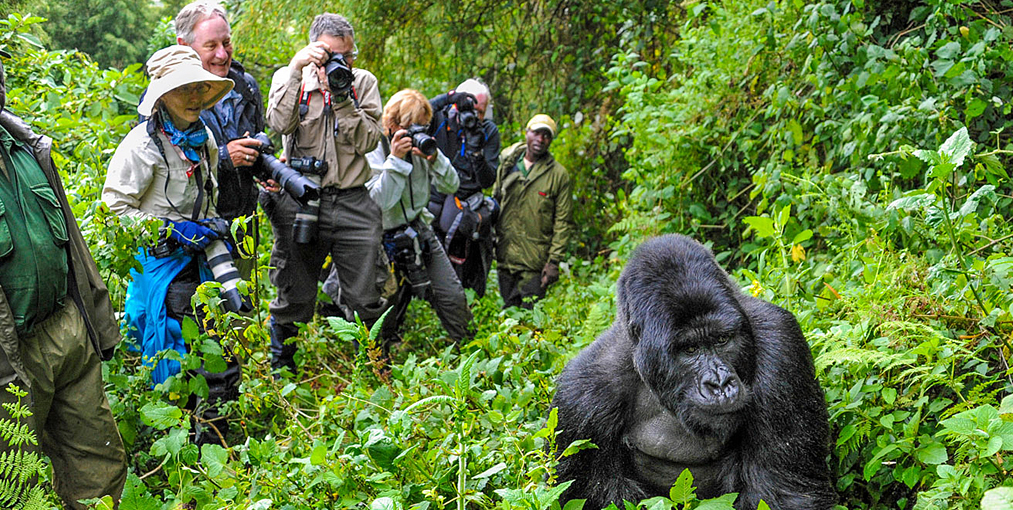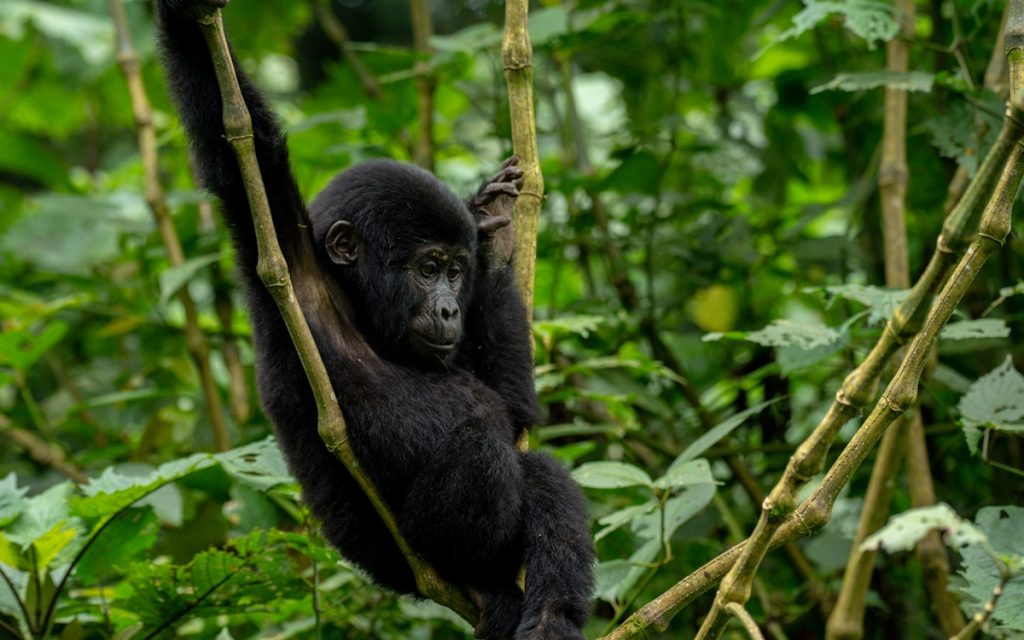- Written by: Friendly Gorillas Editor
- December 19, 2024
What is a Gorilla? | Gorilla Facts
What is a Gorilla? | Gorilla Facts
Gorillas are the world’s largest apes, second closest to humans after the chimpanzees and because of their giant and intimidating size, many humans live in fear of this gentle giant yet, gorillas are actually very smart, sensitive and emotional beings.
Today, we are putting clarity to the question, what is a gorilla? In this in-depth answer, we shall answer all questions and give you all the facts you need to know about a mountain gorilla or lowland gorilla.
If you are in a rush and prefer simplified answers;
Gorillas are the largest known apes that live in the wild. Despite being about 10 times stronger than humans, they share 98.3% of their DNA with us, making them our closest relatives after chimpanzees and bonobos.
There are two major species of gorillas that is; the eastern and western gorillas. Each species has two subspecies: eastern lowland gorillas, eastern mountain gorillas, western lowland gorillas, and western Cross River gorillas.

Whether eastern or wester, gorillas live in small groups of about 10-30 individuals called families or gorilla troops.
Some gorilla families are small and may have 5 to 10 members. This is usually a new group that has just split from a bigger group after developing many adult gorillas that believe they can live on their own.
All gorillas live a polygamous mating lifestyle with a dominant adult silverback/blackback male leading and mating with all the females.
When it comes to reproduction, gorillas share a lot with humans. Females are fertile for a few days each month, carry their babies for 8 to 9 months, and usually give birth to one infant at a time.
After nurturing their young for several years, females become pregnant again, but they only reproduce every four to six years.
Gorillas are known to be emotional creatures and express a wide range of emotions, from laughing during play to mourning their dead. They exhibit various communication mechanisms such as sounds, from grunts and whimpers to roars and hoots.
Their strength helps them break apart plants, like banana trees, to acquire food, protect the family from predators and other members and more.
Gorilla species
Gorillas belong to the genus Gorilla consists of two species: the eastern gorilla (Gorilla beringei) and the western gorilla (Gorilla gorilla).
The eastern gorilla has two subspecies: the mountain gorilla (G.b. beringei) found in Uganda’s Bwindi & Mgahinga Gorilla Parks, Rwanda’s Volcanoes National parks and D.R. C’s Virunga’s National parks and the eastern lowland gorilla (G.b. graueri) found majorly in the lowland and Eastern Albertine montane forests of Democratic Republic of the Congo.
The western gorilla is further subdivided into two subspecies: the western lowland gorilla (G.g. gorilla) and the Cross River gorilla (G.g. diehli).
Suggested Safari Itineraries
Gorilla social structure
With a highly evolved and intricate social structure, gorillas live in family groups that normally consist of five to ten members, though they can vary as much as two to fifty members.
One or two males (silverbacks), females, babies, and young adult males (black backs) usually make up the family. The dominant male or males might hold the title of “head of the family” for an extended period of time. The silverbacks are the family’s leaders.

Mountain Gorilla
When a male matures and becomes an adult, he will both depart from the group and find his own territory close to his ancestral home or he will stay with the group and become the dominant male’s offspring, who will eventually assume leadership of the group.
Gorilla life cycle
Male gorillas often do not attain sexual maturity until they are 15 years old, whilst female gorillas reach sexual maturity at the age of 7-8 but do not start breeding until a few years later.
Gorilla gestation period
Gorilla females typically give birth once every four years. They usually give birth to a single child throughout the eight and a half month (257 day) gestation period. Over her lifetime, the female will only give birth to three or four children. The low reproduction rate of gorillas poses a challenge to their ability to rebound from population decreases.
Gorilla life expectancy
In the wild, gorillas often live 35 to 40 years of age. At maturity, female gorillas split off from their group to live with other groups or with lone males.
Communication and sounds
The gorilla is a peaceful and rather shy animal.
Wild gorillas utilize a range of cries to communicate, including as grunts, hoots, barks, and roars (which are reserved for the more aggressive males). A gentle and non-aggressive species, gorillas do not bite unless they are agitated beyond reason.

Where to see gorillas
If you’re planning to see gorillas, it’s important to know the different subspecies and yes, you shall not find them inhabiting the same habitat.
Mountain Gorillas
Mountain gorillas which are the most sought after gorillas by tourists like you, can be found in Uganda’s Bwindi Impenetrable National Park & Mgahinga Gorilla National park, Rwanda’s Volcanoes National Park and Democratic Republic of Congo’s Virunga National Park.
Mountain gorillas only live in high-altitude montane forests and cannot survive in zoos.
Mountain gorilla trekking Permit Cost is between $450 – $1,500, depending on the country and gorilla trekking season.
Eastern Lowland Gorillas
The eastern lowland gorillas can only be trekked in Democratic Republic of Congo (Kahuzi-Biega National Park).
Habitat: Found in lowland tropical forests.
Permit Cost: Around $400 per person per day.
Eastern lowland gorillas are larger than mountain gorillas and less frequently seen by tourists due to their more remote location.
Western Lowland Gorillas
Where: Gabon (Loango National Park), Cameroon (Dja Faunal Reserve).
Habitat: Lowland tropical forests.
Permit Cost: Varies.
Cross River Gorillas
Where: Nigeria and Cameroon (Cross River National Park).
Habitat: Dense, remote forests.
Permit Cost: Varies.
The rarest of all gorilla subspecies, they are difficult to track and rarely seen by tourists due to their small population.
Recommended Safaris

Why mountain gorillas are so important
Just like all other wild animals, gorillas have a key role to play in their ecosystems by helping control vegetation. Without them, the balance of the food chain would be disrupted, which could harm other wildlife and the local communities that rely on the land for food and resources.
Well-managed and carefully guided gorilla safaris offer a sustainable income for nearby communities, contributing to both their welfare and gorilla conservation.
Conclusion
These powerful, fur-coated apes are among humans’ closest relatives immediately after chimpanzees. Unfortunately, humans pose the biggest threat to the gorilla survival. For many decades now, human encroachment has been shrinking the mountain gorilla’s habitat.
Up until the present day, only around 1,200 remain in the wild.
Planning a gorilla visit is incredibly the only way to watch them in their natural habitat. However, you need to purchase your gorilla permit that costs USD 800 in Uganda and USD 1,500 in Rwanda and USD 450 in D.R.C. The price is per person per day.
Get in touch for details.
Friendly Gorillas Editor

Ready for your ultimate wildlife experience?
Chat with us, our team is always here to help!
You may also like …

Got any questions
about traveling to Uganda?
Get in touch.








